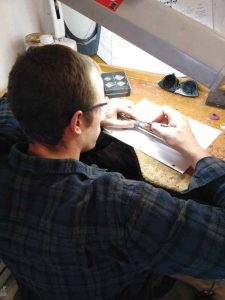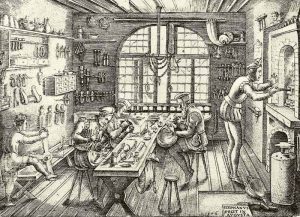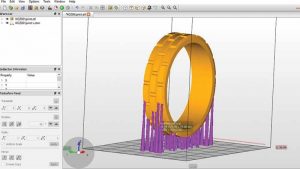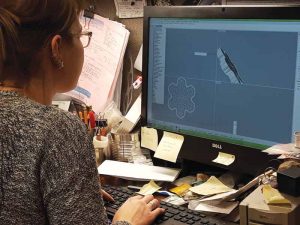Teaching tech: Is the industry moving too fast?
by carly_midgley | February 21, 2018 7:53 am
By Andrea Wenckebach
 [1]
[1]In the last couple of decades, there have been incredible new innovations and technological advances in the jewellery industry. Keeping up with these changes is an essential function of the curricula of many community college jewellery programs. As such, those programs must continually evolve.
As an educator of the next generation of goldsmiths, I often reflect on the implications of recent technological changes we’ve seen within the jewellery industry and how they will affect what I do in the classroom. It is, however, rarely easy to understand what kind of innovations are important or which will be widely adopted by the industry. Additionally, technology is often very costly to buy and run, a fact that limits what many programs can offer. Adequately preparing graduates of these programs to enter the workforce, therefore, is challenging.
The more things change…
Étienne Delaune, a French goldsmith who worked in Paris in the 1550s, created a number of engraved prints. Among those prints were a few depictions of goldsmiths’ workshops. These 400-year-old engravings show files, draw benches, drawplates, hammers, stakes, pliers, bench pins, and draw tongs, among other tools, which look the same or extraordinarily similar to the hand tools we still commonly use in our jewellery repair shops and custom jewellery stores today. If we in the jewellery trade are still using the same hand tools we have for hundreds of years, perhaps the industry really hasn’t changed that much.
According to Brett Thompson of Gesswein Canada, only approximately 20 per cent of his customer base spends more than $5000 every four or five years on high-tech equipment. Thompson asserts over the years, the most common question he has heard from his customers is, “How much is it going to cost?” In contrast, he claims, in the United States the question tends to be, “How much money will that machine make me?”
 [2]
[2]“Until recently,” Thompson explains, “Canadian jewellery retailers hadn’t embraced technology as much as we thought they would. For manufacturers of newer technologies, the Canadian market is too small, and the industry has been leery of incurring extra costs to bring in cutting-edge technology.”
Very recently, however, he has seen changes with a few retailers starting to spend more money to adopt some of the technological advances spreading throughout the industry.
The keys to keeping current
 [3]
[3]Laser welders, 3D printers, and design software are just some of the fairly new advances becoming more accepted in the jewellery stores of our nation. However, if Thompson is right that only 20 per cent of the Canadian jewellery industry is embracing these shiny new tools and only a few others are starting to come on board, is it worth changing our training programs? Do we teach our students how to laser weld if the jewellery stores in the towns where they hope to work don’t have laser welders or any plans of getting them? Dana Smith of Dana’s Goldsmithing in Port Perry, Ont., thinks so.
“It’s hard finding trained staff,” she explains.
The software program Smith uses for designing jewellery comes equipped with a virtual key that both allows the use of the program and limits its use to a single computer. With business expanding, she needed a second computer and designer to fill all the orders she has been getting. Smith felt it was necessary to hire someone who already owned a key for the same software, as a new key would be very expensive. While she did manage to find someone to fill the position, that person’s key was not up to date, so she ended up purchasing an upgrade to the key for a current version of the software.
Smith is about to embark on a large renovation to her store that will create a completely unique experience for her customers, featuring software containing a huge virtual library, of components to help customers design that special piece.
 [4]
[4]
“Technology, that’s what we’re all about,” she explains enthusiastically. She is also planning to make room for laser welders and 3D printers in her renovation. She keeps wondering what technology is next to come, and says it is difficult to “try to think ahead about how to fit technology into the renovation and stay ahead of the game.”
 [5]
[5]She sees changes growing throughout the industry, and not just in how we create jewellery. From the way we market jewellery and interact with customers to how we can personalize experiences for them, there are remarkable shifts.
“E-mail allows me to have customers from across Canada, and Internet analytics help me pinpoint much more easily which marketing campaigns work and which don’t,” explains Smith.
Kim Kostiuk of Fine-Line Jewellers & Engravers in Edmonton, Alta., says, “The mystique of being a goldsmith, a bench jeweller, will always be there.”
However, he admits he gets incredible precision for the corporate rings he creates using computer-aided design (CAD) software in conjunction with a computer numerical control (CNC) milling machine. Fine-Line Jewellers & Engravers has invested heavily in technology and innovation. The store has a laser welder, casting equipment, pneumatic tools, and will be buying a 3D printer as well, for which Kostiuk has looked into specific software. He says he needs people with computer experience to design the jewellery he creates for his customers.
Bringing innovation to education
 [6]
[6]If the industry is indeed beginning to adopt more technology and use new tool types to create and design jewellery, training of the next generation of goldsmiths should reflect these changes. However, a look at even one of these developments—such as the increasing use of design software—gives an educator pause.
The amount and variety of design software available to the jewellery industry is growing exponentially. There is a wide range of software and plugins for different purposes and applications. As a result, jewellers, goldsmiths, and manufacturers can pick the programs that work best for their specific needs. As a teacher, however, this diversity presents a real conundrum in terms of curriculum planning. It is impossible to teach students all of the software programs the industry is currently using. Yet, trying to pick the one program that might stand out from the crowd and be adopted by even a small portion of the Canadian jewellery trade is akin to using a crystal ball to reveal the future—virtually impossible.
It is not just software that is problematic. Picking newer technologies like 3D printers or laser welders for our programs is challenging not only because we don’t often know how much infiltration into the industry there will be, but also because new technologies have a tendency to be expensive. Cash-strapped colleges are hard-pressed to come up with funds for costly, unproven solutions. Even when funds are available, the levels of approval and time it takes to acquire new technologies make it difficult to keep programs current and students learning on cutting-edge machines.
 [7]
[7]Tyler Teague, who does work for Jewelry Engineering Technology & Training (JETT) Research in Tennessee, has worked in jewellery manufacturing for years and is known for creating products and perfecting engineering processes for the jewellery industry. He asserts with all the technological changes happening in the industry, engineering needs to be part of jewellery training. He is aware many technologies are out of financial reach of the colleges, but maintains a multitude of skills are needed now.
“The jewellery industry has come full circle. For a while the mom-and-pop stores were sending hard-to-make pieces offshore, but now, with technologies like 3D printers, those jobs are coming back home,” he says. “A bench jeweller with CAD skills is more valuable than one without.”
With increasing cutbacks in the college system, money to accommodate all the changes that are already here and those yet to come is scarce. The current federal government, however, seems to have recognized the increasing need for technology and innovation at the postsecondary level. With the Post-Secondary Institutions Strategic Investment Fund, the government has invested $2 billion over three years in infrastructure to bolster research and innovation at Canadian colleges and universities. However, the funding seems earmarked for programs like environmental engineering and computing. Jewellery programs will have to fight for a tiny piece of that innovation money, as they tend to be seen as art programs that don’t require much technology.
Small steps
 [8]
[8]A book sits open in my office showing one of Étienne Delaune’s 440-year-old depictions of a goldsmith’s workshop. A 3D-printed ring sits alongside it, grown in the newest printable wax. I just e-mailed a supplier who may be able to get us a license for 3D modelling software at a reduced cost, and I’m prepping a wax-carving demo for my students.
Kim Kostiuk has had a talented apprentice at his bench for five years. “It’s difficult to find a dedicated, well-rounded goldsmith,” he muses.
It is a challenge for training programs to stay current—to find a balance between teaching old skills and new. However, with a bit of research, essential hand skills, and some reduced costs here and there, college jewellery programs are continually working to give students the kind of rounded education Kostiuk talks about—the kind that will give graduates the skills to be not only current, but also innovators within the industry.
Andrea Wenckebach is a studio jeweller, as well as a full-time faculty member for the jewellery and metals program at Georgian College in Barrie, Ont. She can be reached at andrea.wenckebach@georgiancollege.ca.
- [Image]: https://www.jewellerybusiness.com/wp-content/uploads/2018/02/Grant-Girouard.jpg
- [Image]: https://www.jewellerybusiness.com/wp-content/uploads/2018/02/Etienne-Delaune-Goldsmith-Workshop.jpg
- [Image]: https://www.jewellerybusiness.com/wp-content/uploads/2018/02/bigstock-194089120.jpg
- [Image]: https://www.jewellerybusiness.com/wp-content/uploads/2018/02/asiga-2.jpg
- [Image]: https://www.jewellerybusiness.com/wp-content/uploads/2018/02/asiga-1.jpg
- [Image]: https://www.jewellerybusiness.com/wp-content/uploads/2018/02/20171206_152938.jpg
- [Image]: https://www.jewellerybusiness.com/wp-content/uploads/2018/02/bigstock-Female-Engineer-Using-CAD-Syst-98580284.jpg
- [Image]: https://www.jewellerybusiness.com/wp-content/uploads/2018/02/20171206_153442.jpg
Source URL: https://www.jewellerybusiness.com/features/teaching-tech-industry-moving-fast/